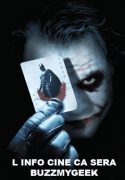Le producteur, le réalisateur et le scénariste parlent ici du processus de création des monstres du film. Pour ceux qui veulent garder l'esprit frais de tout spoilers mieux vaut ne pas lire les paragraphes suivants.
attention: extrait entièrement en anglais.
————————————————-
————————————————-
————————————————-
Reeves also skillfully interweaves an important storyline throughout the film, that of Rob and Beth’s (Odette Yustman) earlier relationship. Hud is unknowingly taping over an earlier recording Rob had made with the camera of intimate, quiet time spent with his mate. “You see their loving gaze. It’s this small love story,” says Reeves.
“So I began thinking, ‘Isn’t there some way to make that kind of a parallel story?’” The film actually begins with some of this footage – much of it shot by Michael Stahl-David himself using a small video camera. But additional portions also appear interspersed throughout the movie, typically after some shocking event has caused Hud to briefly shut off the camera, allowing a brief portion of Rob’s original recording to play for the audience before Hud picks up the current action again.
“We’re seeing the aftermath of two people who have longed to be together, and somehow finally come together, crosscut with this other event,” the director explains. “By going back and forth between these two pieces, you end up heightening the drama. By looking back at this relationship and what it could have been, the audience starts to put the pieces together as to why Rob is so eager to rescue her.”
Building a Better Monster
The visual effects for “Cloverfield” were produced under the direction of visual effects supervisors Kevin Blank, Eric Leven of Tippett Studio and Michael Ellis of London-based Double Negative. Tippett created all the shots that include the monsters, while Double Negative was responsible for all of the other destruction and sequences which did not include the monster.
The concept for the monster (affectionately known simply as “Clover” in-house) is simple, says Abrams. “He’s a baby. He’s brand-new. He’s confused, disoriented and irritable. And he’s been down there in the water for thousands and thousands of years.”
And where is he from? “We don’t say – deliberately,” notes Goddard. “Our movie doesn’t have the scientist in the white lab coat who shows up and explains things like that. We don’t have that scene.”
Not only is the creature disoriented – he’s downright angry. “There are a bunch of smaller things – humans – that are annoying him and shooting at him like a swarm of bees,” observes Reeves. “None of these things are going to kill the monster, but they hurt it and it doesn’t understand. It’s this new environment that it finds frightening.”
For the monster’s design, Abrams engaged veteran creature designer Neville Page, who had just finished creating characters for James Cameron’s upcoming “Avatar” (and is currently working on Abrams’ “Star Trek”).
“So much has been done in so many different movies with large creatures that the trick was to find a way to create a unique character,” explains Abrams. The producer had first become familiar with Page’s work through the designer’s series of instructional DVDs for The Gnoman Workshop. “One of the things that struck me about Neville’s instructional videos was the way he approaches everything from a realistic point of view. He develops non-existing creatures, but can explain to you their physical makeup, musculature and skeletal structure.”
Adds producer Burk, “Neville was the first person we met with. And he’s amazing. He doesn’t just think about designing the creature, he thinks in terms of how it would walk, how it would breathe, what its skin would be like, how it lives – everything.”
Once Page’s designs were complete, it was up to Tippett Studio to implement and refine the monster for inclusion in the few – but crucial – shots in which he appears. “We did a test, where we inserted him into some background plate shot in downtown L.A.,” explains Leven. “We experimented with different looks, in terms of not only the creature itself, but how it would interact with the camera and with light.”
Another facet of the design was added at director Reeves’ suggestion. “I wanted him to have that sort of spooked feeling, the way, when a horse is spooked, you can see the white of its eyes along the bottom. And you see that when the military is firing on him, where he becomes completely agitated and confused.”
As part of a “post-birth ritual,” as Abrams describes it, the monster is seen early on scratching his back on a building (destroying it in the process), to remove a layer of parasites that are set loose to wreak their own havoc on the city.
“Drew and I were struggling with, ‘When you have a monster that size how do you keep the characters from seeming totally irrelevant?’” says Abrams. “How do you have any one-on-one struggle?” Explains Goddard, “Because he’s so big, we knew it was going to be difficult to have intimate sequences. It’s not like any of the characters could fight him or that anyone could even figure out a way to hurt him.”
And because of that, the idea of the parasites was born. “They’re these horrifying, dog-sized creatures that just scatter around the city and add to the nightmare of the evening,” Abrams says.
“The parasites have a voracious, rabid, bounding nature, but they also have a crab-like crawl,” Reeves explains. “They have the viciousness of a dog, but with the ability to climb walls and stick to things.”
In addition, the parasites also move more rapidly than their giant host counterpart. “Tippett Studio has a lot of expertise with these kinds of fast-moving creatures that can destroy people and rip them to shreds, which is always a lot of fun to work on,” says Leven. “They’re like little whirling dervishes that just destroy anything in their path. They’re totally deadly.”



Commentaires